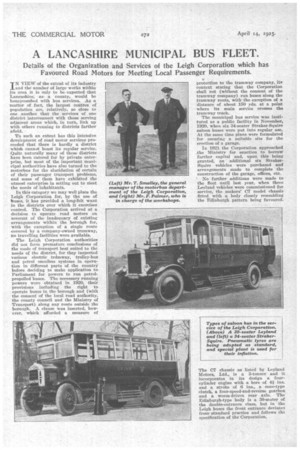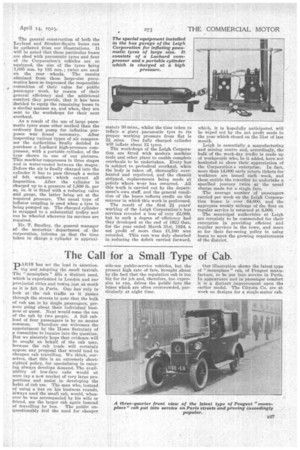A LANCASHIRE MUNICIPAL BUS FLEET.
Page 10

Page 11

If you've noticed an error in this article please click here to report it so we can fix it.
Details of the Organization and Services of the Leigh Corporation which has Favoured Road Motors for Meeting Local Passenger Requirements.
IN VIEW of the extent of its industry and the number of large works within its area it is only to be expected that Lancashire; as a county, would be honeycombed with bus services. As a matter of fact, the largest centres of population are, relatively, so close to one another that the services of one district interconnect with those serving adjacent areas which, in turn, link up with others running to districts farther afield.
To such an extent has this intensive development of road motor services proceeded that there is hardly a district which cannot boast its regular service. Quite naturally many of these districts have been catered for by private enterprise, but most of the important municipal authorities have also turned to the motorbus for the elucidation of certain of their passenger transport problems, and some of them have exhibited the utmost enterprise in setting out to nieet
the needs of inhabitants. • In this category we may well place the Leigh Corporation for, by the use of buses, it has provided a long-felt want in the districts over which it exercises control. The Corporation arrived at a decision to operate road motors on account of the inadequacy of existing arrangements within the borough for, with the exception of a single route covered by a company-owned tramway, no travelling facilities were available.
The Leigh Corporation authorities did not form premature conclusions of the mode of transport best suited to the needs of the district, for they inspected various electric trAmway, trolley-bus and petrol omnibus systems in operation in different parts of the country before deciding to make application to Parliament for powers to run petrolpropelled buses. The necessary running powers were obtained in 1920, their provisions including the right to operate buses in the borough and (with the consent of the local road authority, the county council and the Ministry of Transport) along any route outside the borough. A clause was inserted, however, which afforded a measure of protection to the tramway company, it context stating that the Corporation shall not (without the consent of the tramway company) run buses along the tramway route, with the exception of a distance of about 150 yds. at a point where its main service crosses the tramway track.
The municipal bus service was instituted as a public facility in November, 1920, when six 34-seater Straker-Squire saloon buses were put into regular use. At the same time plans were formulated for securing a suitable site for the erection of a garage.
In 1921 the Corporation approached the Ministry for sanction to borrow further capital and, upon this being granted, an additional six StrakerSquire vehicles were purchased and arrangements made to complete the construction of the garage, offices, etc. ' No further additions were made to the fleet until last year, when three Leyland vehicles were commissioned for service, the makers' CT model chassis fitted with a body closely resembling the Edinburgh pattern being favoured.
The 07 chassis as listed by Leyland Motors, Ltd., is a 3-tonner and it incorporates in its design a fourcylinder engine with a bore of di ins. and a stroke of 6 ins., a cone-type clutch, a four-speed-and-reverse gearbox and a worm-driven rear axle. The Edinburgh-type body is a 30-seater of the double-entrance class, but in the Leigh buses the front entrance deviates from standard practice and follows the specification of the Corporation.
The general construction of both the Leyland and Straker-Squire buses can be gathered from our illustrations. It will be noted that these particular buses are shod with pneumatic tyres and four of the Corporation's vehicles are so equipped, the size of the tyres being 1,085 mm. by 185 mm. ; twins are used on the rear wheels. The results obtained from these large-size pneumatics have so impressed the responsible committee of their value for public passenger work, by reason of their general efficiency and the additional comfort they provide, that it has been decided to equip the remaining buses in a similar manner as, and when they are sent to the workshops for their next overhaul.
As a result of the use of large pneumatic tyres some other method than the ordinary foot pump for inflation purposes was found necessary. After inspecting various types of air compressor the authorities finally decided to purchase a Luchard high-pressure compressor, with a portable cylinder, of the type shown in one of our pictures. This machine compresses in three stages and is water-cooled between the stages. Before the air is finally charged into the cylinder it has to pass through a series of felt washers which extract all Impurities. After the cylinder is charged up to a pressure of 1,800 lb. per sq. in, it is fitted with a reducing valve and gauge, the latter being set at the required pressure. The usual type of inflator coupling is used when a tyre is being pumped up. The charged cylinder is strapped to a substantial trolley and can be wheeled wherever its services are required.
Mr. T. Smalley, the general manager of the motorbus • department of the corporation, informs us that the time taken to charge a cylinder is approxi . mateiy 30 mine., whilst the time taken to inflate a giant pneumatic tyre to its proper working pressure from flat is 2-fr mins. ,One fully charged cylinder will inflate about 12 tyres.
The worksbopi of the Leigh CorporatiOn are fitted with modern machine tools and other plant to enable complete overhauls to be undertaken. Every bus is subject to periodical overhaul, when the body is taken. off, thoroughly overhauled and repainted, and the chassis stripped, replacements being made at points where wear -has occurred. All this work is carried out by the department's own staff, and the general condition of the buses reflects credit on the manner in which this work is performed.
The result of the first 2-i years' working of the Leigh Corporation's bus services revealed a loss of over £2,000, but to midi a degree of efficiency had they developed at the end of 1923 that, for the Year ended. March 31st, 1924, a net profit of more than i1,100 was recorded: This sum was duly absorbed in reducing the deficit carried forward,
which, it is hopefully anticipated, will be wiped out by the net profit made in the year which closed on the 31st of last month.
Leigh is essentially a manufacturing and mining centre and, accordingly, the bulk"of the week-day traffic is made up of workpeople who, be it added, have not hesitated to show their appreciation of the Corporation s enterprise. In fact, more than 14,000 early return tickets for workmen are issued each week, and these entitle the traveller to undertake a specified journey twice at the usual charge made for a single fare.
The average number of passengers carried per week on the Leigh Corporation buses is over 04,000, and the aggregate weekly mileage of the fleet on regular service is returned at 8,000.
The municipal authorities at Leigh are certainly to be commended for their enterprise in providing efficient and regular services in the town, and more so for their far-seeing policy in using buses to meet the growing requirements of the district.






























